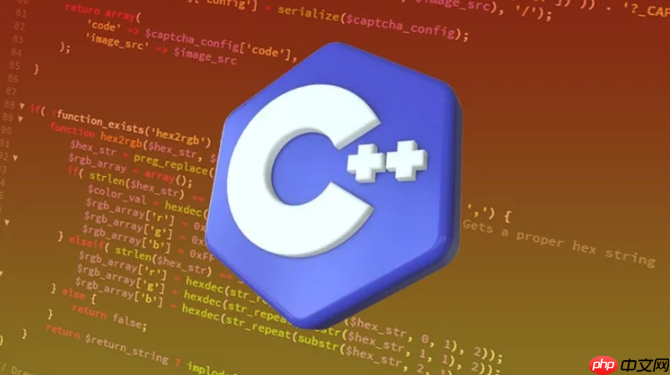重载比较运算符可自定义结构体比较逻辑,默认为逐成员浅比较,可能不符合业务需求。通过重载==、!=、<等运算符,能精确控制相等性与排序行为,尤其在包含指针时需深比较内容并处理内存安全,同时遵循const修饰、对称性、传递性等最佳实践,并配合拷贝构造、赋值运算符和析构函数实现资源正确管理。

C++结构体比较的核心在于如何定义“相等”。默认情况下,结构体比较是逐个成员的浅比较,但这通常不满足实际需求。重载比较运算符,可以自定义比较逻辑,更精确地控制结构体之间的比较方式。
重载比较运算符实现
#include <iostream>
struct MyStruct {
int x;
int y;
std::string name;
// 重载 == 运算符
bool operator==(const MyStruct& other) const {
// 自定义比较逻辑:只有x和y相等时才认为两个结构体相等
return (x == other.x) && (y == other.y);
}
// 重载 != 运算符 (建议同时重载 == 和 !=)
bool operator!=(const MyStruct& other) const {
return !(*this == other); // 利用已定义的 == 运算符
}
// 重载 < 运算符 (可选,用于排序等场景)
bool operator<(const MyStruct& other) const {
// 比较逻辑:先比较x,再比较y
if (x < other.x) return true;
if (x > other.x) return false;
return y < other.y;
}
};
int main() {
MyStruct s1{1, 2, "Alice"};
MyStruct s2{1, 2, "Bob"};
MyStruct s3{3, 4, "Charlie"};
if (s1 == s2) {
std::cout << "s1 and s2 are equal (based on x and y)" << std::endl;
} else {
std::cout << "s1 and s2 are not equal" << std::endl;
}
if (s1 != s3) {
std::cout << "s1 and s3 are not equal" << std::endl;
} else {
std::cout << "s1 and s3 are equal" << std::endl;
}
if (s1 < s3) {
std::cout << "s1 is less than s3" << std::endl;
} else {
std::cout << "s1 is not less than s3" << std::endl;
}
return 0;
}为什么要重载比较运算符?默认的比较行为是什么?
默认的比较行为是逐字节比较,这通常不是我们想要的。例如,在上面的例子中,即使
s1
s2
name
x
y
==
s1 == s2
name
立即学习“C++免费学习笔记(深入)”;
重载比较运算符时有哪些最佳实践?
==
!=
!(a == b)
a != b
a == b
b == a
a == b
b == c
a == c
a == a
true
const
<
<
>
<=
>=
如何处理结构体中包含指针或动态分配的内存的情况?
当结构体包含指针或动态分配的内存时,重载比较运算符需要特别小心,以避免悬挂指针或内存泄漏。
#include <iostream>
#include <string>
struct MyString {
char* data;
size_t length;
// 构造函数
MyString(const char* str) {
length = std::strlen(str);
data = new char[length + 1];
std::strcpy(data, str);
}
// 析构函数 (重要:释放内存)
~MyString() {
delete[] data;
}
// 拷贝构造函数 (重要:深拷贝)
MyString(const MyString& other) : length(other.length) {
data = new char[length + 1];
std::strcpy(data, other.data);
}
// 赋值运算符 (重要:深拷贝 + 避免自赋值)
MyString& operator=(const MyString& other) {
if (this != &other) { // 避免自赋值
delete[] data; // 释放旧的内存
length = other.length;
data = new char[length + 1];
std::strcpy(data, other.data);
}
return *this;
}
// 重载 == 运算符
bool operator==(const MyString& other) const {
if (length != other.length) {
return false;
}
return std::strcmp(data, other.data) == 0;
}
// 重载 != 运算符
bool operator!=(const MyString& other) const {
return !(*this == other);
}
};
int main() {
MyString s1("hello");
MyString s2("hello");
MyString s3("world");
if (s1 == s2) {
std::cout << "s1 and s2 are equal" << std::endl;
} else {
std::cout << "s1 and s2 are not equal" << std::endl;
}
if (s1 != s3) {
std::cout << "s1 and s3 are not equal" << std::endl;
} else {
std::cout << "s1 and s3 are equal" << std::endl;
}
return 0;
}在这个例子中,
MyString
data
==
以上就是C++结构体比较操作 重载比较运算符实现的详细内容,更多请关注php中文网其它相关文章!

每个人都需要一台速度更快、更稳定的 PC。随着时间的推移,垃圾文件、旧注册表数据和不必要的后台进程会占用资源并降低性能。幸运的是,许多工具可以让 Windows 保持平稳运行。

Copyright 2014-2025 https://www.php.cn/ All Rights Reserved | php.cn | 湘ICP备2023035733号